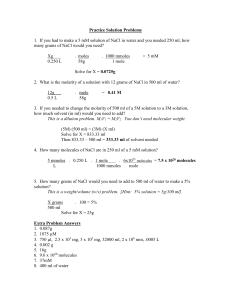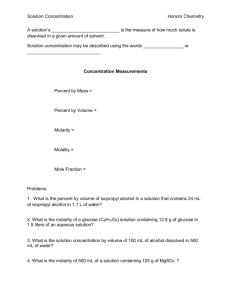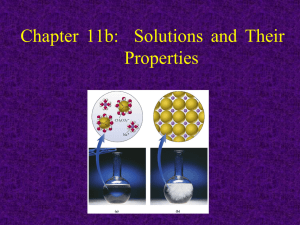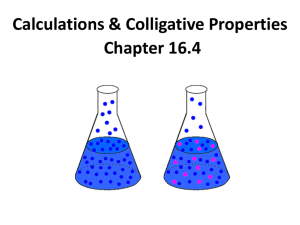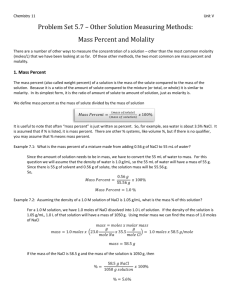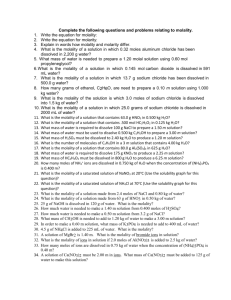Honor*s Chemistry
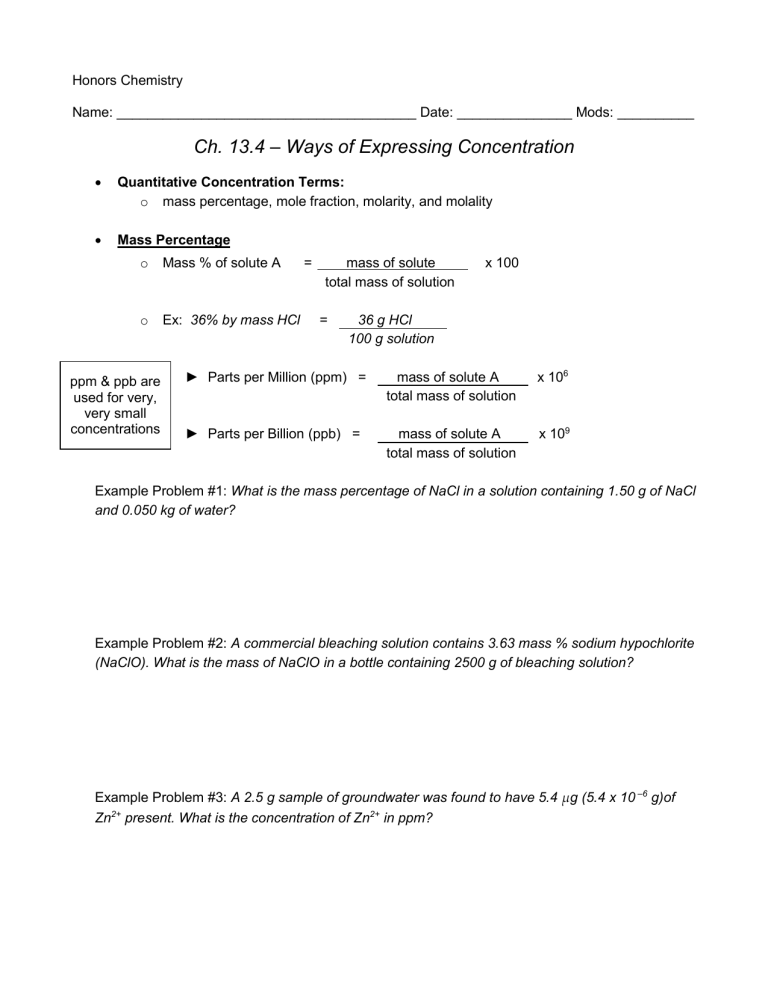
Honors Chemistry
Name: _______________________________________ Date: _______________ Mods: __________
Ch. 13.4 – Ways of Expressing Concentration
Quantitative Concentration Terms: o mass percentage, mole fraction, molarity, and molality
Mass Percentage o Mass % of solute A = mass of solute x 100
total mass of solution o Ex: 36% by mass HCl = 36 g HCl
100 g solution ppm & ppb are used for very, very small concentrations
► Parts per Million (ppm) = mass of solute A x 10
total mass of solution
6
► Parts per Billion (ppb) = mass of solute A x 10 9
total mass of solution
Example Problem #1: What is the mass percentage of NaCl in a solution containing 1.50 g of NaCl and 0.050 kg of water?
Example Problem #2: A commercial bleaching solution contains 3.63 mass % sodium hypochlorite
(NaClO). What is the mass of NaClO in a bottle containing 2500 g of bleaching solution?
Example Problem #3: A 2.5 g sample of groundwater was found to have 5.4 µ g (5.4 x 10
–6
g)of
Zn 2+ present. What is the concentration of Zn 2+ in ppm?
Mole Fraction (X) o X
A
= moles of A
total moles in solution o Unitless!
o Most useful for gas solutions o IN some applications, one needs to the mole fraction of solvent, not solute – make sure you find the quantity you need!
o Ex: 0.445 N
2
= 44.5 moles N
2
100 moles of solution
Example Problem #4: What is the mole fraction of HCl, X
HCl
, when 36.5 g HCl is dissolved in 144 g
H
2
O?
Molarity (M) o M = mol of solute
L of solution o Compares moles solute to volume of solution o Because volume is temperature dependent, molarity can change with temperature. o Ex: 2.0 M NaCl = 2.0 moles NaCl
1 L solution
Molality (m) o m = moles of solute
kg solvent o Because both moles and mass do not change with temperature, molality (unlike molarity) is not temperature dependent so it is often used when a solution will be used over several temperature ranges.
o Ex: 0.75 m HNO
3
= 0.75 moles HNO
3
1 kg H
2
O
Example Problem #5: What is the molality, m, when 36.5 g C
10
H
8
is dissolved in 425 g C
7
H
8
?
Concentration Conversions: o If we know the density of a solution, we can convert the molality to molarity and vice versa:
Example Problem #6: A solution contains 5.0 g C
7
H
8
and 225 g C
6
H
6
. The solution has a density of 0.876 g/mL. What is the molarity, M, of this solution?
Solute Solvent Solution moles grams liters
Example Problem #7: An aqueous solution of HCl is 36% by mass. Calculate the mole fraction of
HCl in solution. What is the molality, m, of this solution?
Solute Solvent Solution moles grams liters
Concentrations WS
6.
4.
Mass Percent
2.
1.
3.
Find the mass percent if 6.70 grams of NaCl are dissolved in 125.6 grams of water.
Find the mass percent if 0.250 mols of KOH are dissolved in 365.0 grams of water.
How many grams of KNO is 4.35% by mass?
3
are dissolved in 800.0 grams of water if the solution concentration
How many grams of water are needed to dissolve 5.60 grams of KClO
5.00% by mass solution?
3
in order to make a
5. How many mols of NaCl are dissolved in 456.0 grams of water if the solution concentration is
2.25% by mass?
You would like to prepare 425 g of an aqueous solution containing 2.40% by mass of sodium acetate. What mass, in grams, of NaC
2
H
3
O
2
will you need to make this solution? What mass of water is to dissolve the sodium acetate in order to make 425 g of the total solution?
Mole Fractions
7. What is the mol fraction of NaCl in a solution if 12.0 grams of NaCl are dissolved in 300.0 grams of water?
8. If the mol fraction of LiOH is 0.0450 in a solution containing 250.0 grams of water, how many grams of LiOH are dissolved?
9. a) If the mol fraction of NaNO
3
is 0.0244 in an aqueous solution that contains a total of 5.67 mols of particles, how many grams of NaNO
3
are present? b) How many grams of water are present? c) What is the mass percent of NaNO
3
in this solution?
Molality
10. What is the molality of a solution that consists of 56.7 grams of SrCl
2
dissolved in 1325.0 grams of water?
11. What is the molality of a solution that consists of 32.0 grams of FeCl
3
dissolved in 2250 grams of water?
Converting between Concentrations WS
Directions: Setup solutions tables to help you solve the following problems which require you to convert between various concentration terms.
1. Converting molality to molarity:
What is the molarity of a 0.273 m aqueous solution of KCl? The density of the solution is 1.011 g/mL.
2. Converting molarity to molality:
An aqueous solution is 0.907 M Pb(NO
3
)
2
. What is the molality of lead (II) nitrate in this solution? The density is 1.252 g/mL.
3. Converting mass percent to mole fraction:
Calculate the mole fraction of NaCl in a 5% by mass aqueous solution of NaCl.
4. Converting mass percent to molarity:
Reagent grade concentrated aqueous ammonia is 27% by mass NH
3
and has a density of
0.90 g/mL. What is the molarity of this solution?
5. Converting mole fraction to molality:
If the mole fraction of Na
2
CO
3
is 0.0340 in an aqueous solution, what is the molality of the solution?
6. Converting mass percent to molality:
What is the molality of a 4.50% by mass aqueous NaOH solution?
Concentration Conversion Practice WS
1. Write the definition (in formula form) of each concentration in terms of solute , solvent , and/or solution : molarity (M) molality (m) mole fraction (X) mass percent (%)
2. Assume you dissolve 2.56 g of malic acid, C
4
H
6
O
5
, in half a liter of water (500.0 g). The density of the solution is equivalent to that of water, 1.0 g/mL.
Solutions Table: a) Calculate the molarity of this solution: b) Calculate the molality of this solution: c) Calculate the mole fraction of C
4
H
6
O
5
in this solution: d) Calculate the mass percent of C
4
H
6
O
5
in this solution:
3. Set up three different solution tables (one for each compound) and use the resulting information to fill in the blanks in the table below.
Aqueous Solution of: Molality Mass Percent Mole Fraction
NaI 0.15
C
2
H
5
OH
C
12
H
22
O
11
C
2
H
5
OH:
NaI:
C
12
H
22
O
11
:
5.0
0.064

